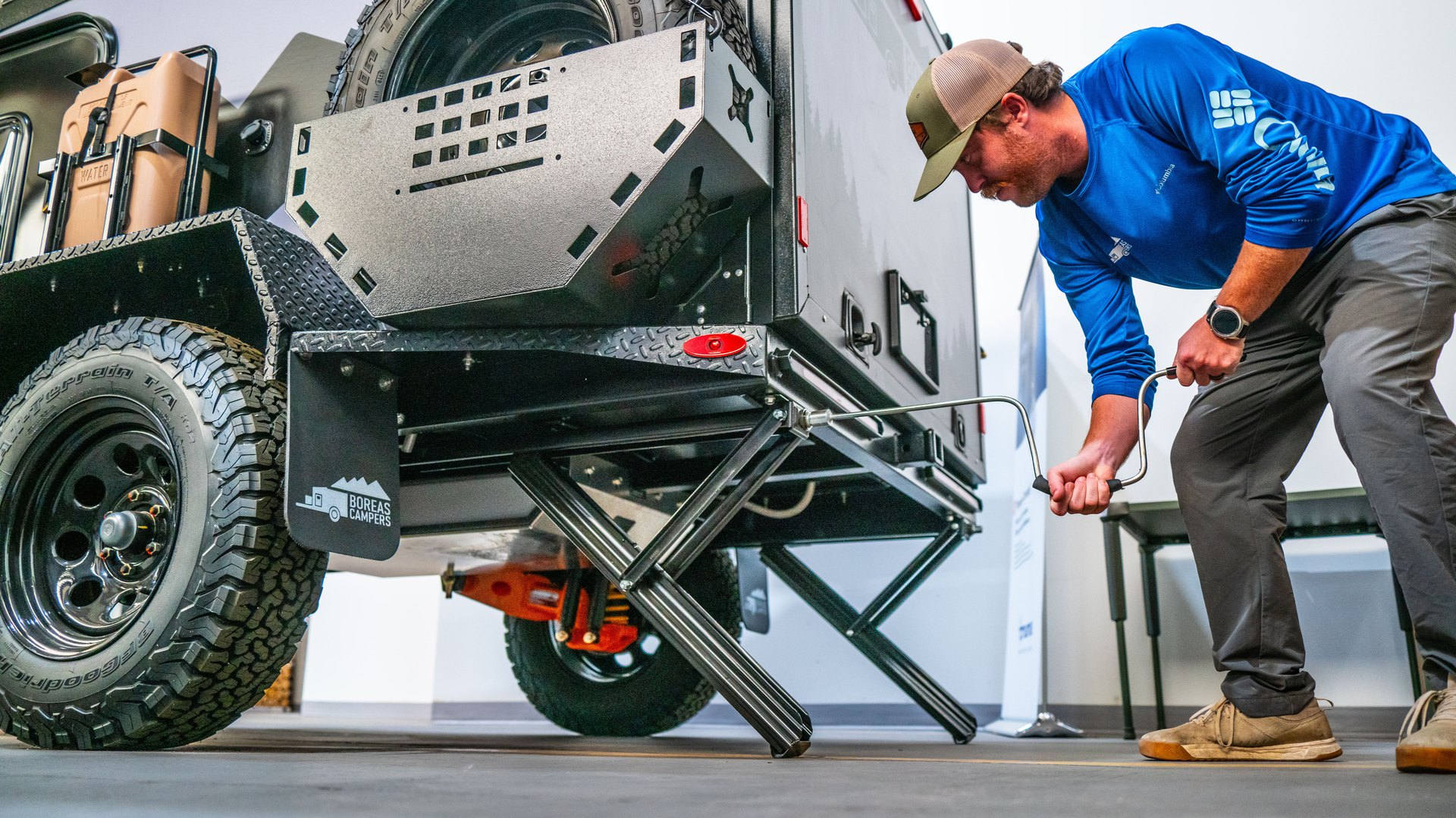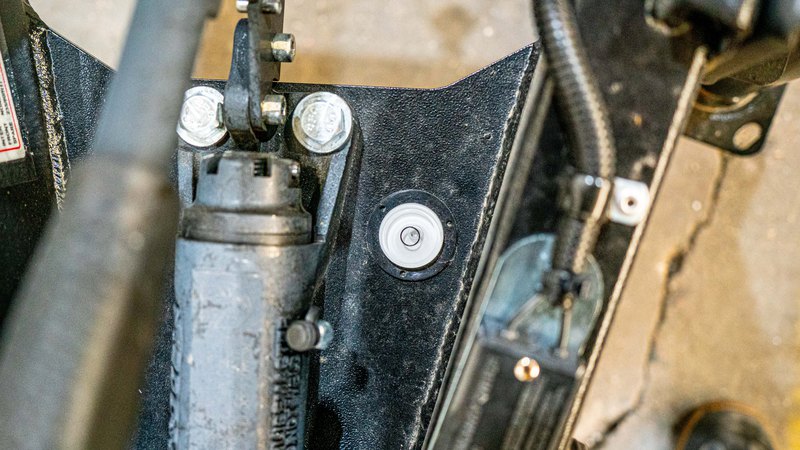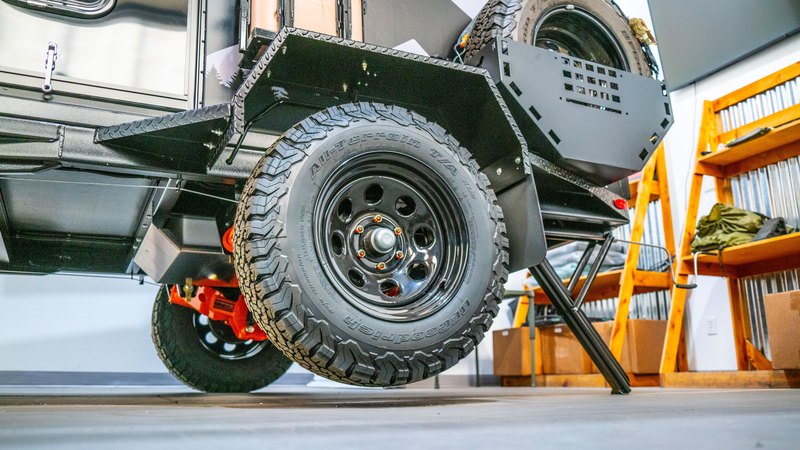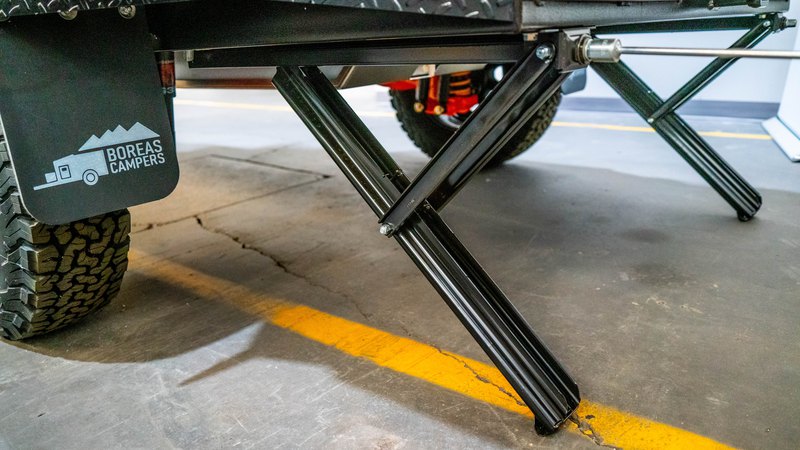
REAR STABILIZER JACK USAGE AND GUIDELINES FOR THE XT
RV stabilizer jacks are designed to reduce movement and sway within your camper when it's parked and set up at a campsite. For the Boreas Campers XT the stabilizer jacks can provide many different uses, however they do have their limitations. Today we’ll cover the proper levelling procedure for your XT and the do’s and don’ts of the rear stabilizer jacks.
The rear stabilizer jacks have a 3000 lb weight capacity as a pair, so 1500 lbs of static capacity per side. This capacity is important to note as your trailer falls well under that weight limit, however that does not mean the cranking mechanism is built to lift that kind of weight. The jacks can only hold that weight statically. Keeping this in mind, let’s go over how to use these jacks to level your XT.

For levelling your camper follow these steps:
1. Before attempting to stabilize your XT, it's essential to park on the most level surface you can find. Being an offroad camper, chances are your destination doesn’t have a nicely groomed flat area, but taking the time to find the most level surface will not only speed up your camp setup and takedown process, it will also ensure a more stable camper to sleep in.
2. Unhitch your trailer from the tow vehicle. Unless you’re in the most perfectly level spot this will make the leveling process a lot easier.
3. We recommend having a pair of portable jack pads to keep in your camper. They help a lot in loose rock/soil or muddy conditions. They are also relatively inexpensive and can be found at most local hardware stores. If you have a pair place them in the center of the jacking area.
4. Grab your stabilizer jack crank handle and crank the jacks down until they barely touch the ground or jack pads. Avoid using any power tools during the cranking process. Although tempting, it will likely ruin your jacks within a few uses as they are only designed to move at a slow rpm under human strength.
5. Check your bubble levels and see which portions of the camper need to be raised or lowered. If the front seems high do not jack up both rear levelers to meet the front. Rather lower the front jack on the tongue to meet the rear of the camper. You’ll thank us later when you can still reach into your kitchen cabinets without having to get on your tippy toes.

6. If one side needs to be raised to level the camper side to side then crank the appropriate jack to level the camper. The rule of thumb is that both tires should ALWAYS be on the ground. Once you get to the point where you’ve cranked on the jack hard enough that the tire has left the ground then your jack is maxed out and should be lowered until both tires are touching. You will also feel it in your arms as the jack crank will be very difficult to turn at this point.
If your camper still isn’t level then you will either have to move the camper to find a more level spot or endure a night with a camper that’s not perfectly level. Remember that stabilizer jacks are not designed to lift your camper off the ground. They are meant to provide support and minimize movement.
7. Once level, check your work by going in the cabin and moving around inside. You should notice a significant reduction in movement.

Boreas Campers has stated in the past that the rear stabilizer jacks can be used to change a tire on the XT if you’re in a pinch. They will raise the trailer frame up high enough to do so, however this comes with great risk of damaging the jack and we urge that this method only be used if there are no other options available.
If you are going to change a tire using the rear jack here are some things to consider:
Find the most level spot you can to change the tire. The jack will be heavily stressed if you are on a slope which could increase the risk of damaging the jack or personal injury.
Make sure you are only jacking up one side at a time. Jacking up both sides at the same time will almost surely damage one or both jacks.
Chock the wheel on the opposite side of the camper with a set of wheel chocks.
Break the lug nuts free while the tire is on the ground and then jack up the camper. This will avoid swaying the jacks back and forth under heavy weight. Also, once the tire is swapped, be sure to torque the lug nuts while the tire is on the ground, not in the air.

Lastly, we’ll want to go over maintenance.
The jack manufacturer recommends lubricating the threads of the jack and bearing area with WD-40 as needed. If the jacks become difficult to turn or there is a lot of visible surface rust then you should apply the WD-40 or similar product to the affected areas. Remember, even if you don’t use the jacks that often they are still under the trailer frame and exposed to harsher elements like road grime, magnesium chloride, salts, etc. XT owners should check and make sure both jacks are operating properly before leaving on each camping trip.